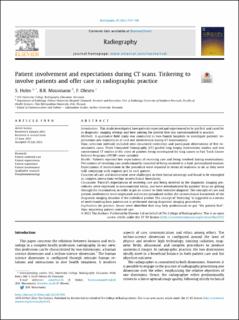| dc.contributor.author | Holm, Susie | |
| dc.contributor.author | Mussmann, Bo | |
| dc.contributor.author | Olsen, Finn | |
| dc.date.accessioned | 2024-01-11T09:49:07Z | |
| dc.date.available | 2024-01-11T09:49:07Z | |
| dc.date.created | 2024-01-09T21:54:45Z | |
| dc.date.issued | 2023 | |
| dc.identifier.citation | Radiography. 2023, 29 935-940. | en_US |
| dc.identifier.issn | 1078-8174 | |
| dc.identifier.uri | https://hdl.handle.net/11250/3111032 | |
| dc.description.abstract | ntroduction: This study investigated how patients expected and experienced to be put first and cared for
in diagnostic imaging settings and how putting the patient first was operationalized in practice.
Methods: A qualitative field study was conducted in two Danish hospitals to investigate patients’ ex-
pectations and experiences of care and involvement during CT examinations.
Data collection methods included semi-structured interviews and participant observations of five ex-
amination cases. Three Computed Tomography (CT) guided lung biopsy intervention studies and two
conventional CT studies of the chest of patients being investigated for lung cancer in Fast Track Cancer
Referral Programs (FTCRP) were included.
Results: Patients reported low expectations of receiving care and being involved during examinations.
Perceptions of receiving care predominantly consisted of being received in a kind, personalized manner.
Expectations of involvement in the procedure were reported in terms of readiness to do as they were
told, complying with requests put to each patient.
Concepts of care and involvement were challenged in their formal meanings and found to be entangled
in complex interactions within sociotechnical boundaries.
Conclusion: Patient's expectations of receiving care and being involved in the diagnostic imaging pro-
cedures, were expressed in noncommittal terms, and were overshadowed by patients' focus on getting
through the examination, in order to get an answer to their tentative diagnose. The concepts of care and
patient involvement were negotiated and reconceptualized within the sociotechnical framework of the
diagnostic imaging situation of the individual patient. The concept of “tinkering” is suggested as a means
of understanding how patientcare is performed during diagnostic imaging procedures.
Implications for practice: Issues were identified that may help professionals to put “the patient first”,
thus, improving patient centered care. | en_US |
| dc.language.iso | eng | en_US |
| dc.rights | Navngivelse 4.0 Internasjonal | * |
| dc.rights.uri | http://creativecommons.org/licenses/by/4.0/deed.no | * |
| dc.title | Patient involvement and expectations during CT scans. Tinkering to involve patients and offer care in radiographic practice | en_US |
| dc.type | Peer reviewed | en_US |
| dc.type | Journal article | en_US |
| dc.description.version | publishedVersion | en_US |
| cristin.ispublished | true | |
| cristin.fulltext | original | |
| cristin.qualitycode | 1 | |
| dc.identifier.doi | https://doi.org/10.1016/j.radi.2023.07.005 | |
| dc.identifier.cristin | 2223555 | |
| dc.source.journal | Radiography | en_US |
| dc.source.volume | 29 | en_US |
| dc.source.pagenumber | 935-940 | en_US |

